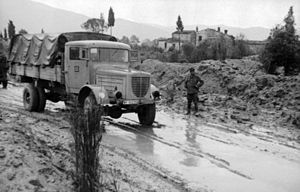Battle of Rimini (1944)
| Battle of Rimini | |||||||
|---|---|---|---|---|---|---|---|
| Part of Italian Campaign (World War II) | |||||||
 German trucks driving through muddy, flooded and unpaved roads near Rimini; typical terrain encountered during the offensive. |
|||||||
|
|||||||
| Belligerents | |||||||
|
|
|
||||||
| Commanders and leaders | |||||||
|
|
|
||||||
| Units involved | |||||||
|
|
|||||||
The Battle of Rimini took place in between 13 and 21 September 1944 during Operation Olive, the main Allied offensive on the Gothic Line in August and September 1944, part of the Italian Campaign in the Second World War. Rimini, a town on the Adriatic coast of Italy, anchored the Rimini Line, a German defensive line which was the third such line forming the Gothic Line defenses. Rimini, which had been hit previously by air raids, had 1,470,000 rounds fired against it by allied land forces. According to Lieutenant-General Sir Oliver Leese, commander of the 8th Army:
"The battle of Rimini was one of the hardest battles of Eighth Army. The fighting was comparable to El Alamein, Mareth and the Gustav Line (Monte-Cassino)."
On 23 August 1944 Eighth Army launched Operation Olive, attacking on a three Corps front up the eastern flank of Italy into the Gothic Line defenses. By the first week in September the offensive had broken through the forward defences of the Gothic Line and the defensive positions of the Green I line and United States Fifth Army entered the offensive in central Italy attacking towards Bologna. In Eighth Army's centre 1st Canadian Corps had broken through Green II on the right of its front advancing to pinch out the Polish Corps on the very right of the army (and allowing the latter to be withdrawn to army reserve) but inland in the hills the Corps' advance had been held up by stubborn defence at Coriano and V Corps on the army's left flank had been halted at Croce and Gemmano. A new attack to clear the Green II positions in the hills and destroy the Rimini Line running from the port of Rimini inland to San Marino was scheduled to start on 12 September.
Just south of Rimini, attached to 1st Canadian Division, was 3rd Greek Mountain Brigade (Greek: ΙΙΙ Ελληνική Ορεινή Ταξιαρχία, ΙΙΙ Ε.Ο.Τ.), a unit of mountain infantry formed by the Greek government in exile on 1 July 1944 in Lebanon under the command of Colonel Thrasyvoulos Tsakalotos. Near the village of Cattolica they pushed back two strong German attacks on 8 and 10 September. On 13 September the brigade, supported by the combined armour and infantry of B squadron, 20th New Zealand Armoured Regiment and 22 New Zealand Motor Battalion from 2nd New Zealand Division, launched a counterattack to take Rimini. Also supporting the brigade were infantry, mortars and machine guns from the Canadian Saskatoon Light Infantry (SLI) and New Zealand 33 Anti-tank battery fielding 17pdr guns.
...
Wikipedia
